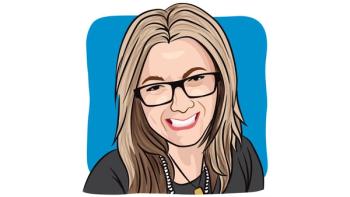
Addressing Mental and Emotional Health in Ovarian Cancer
Transcript:
Shubham Pant, M.D.: Obviously out here in your institution, you have people like you, Dr. Eskander, who can help patients along in their journey. But the majority of the oncology practice is not done in academic centers. It’s done in more community settings. But the resources may not be that robust. What do patients do in that setting?
Jeremy Hirst, M.D.: It can be challenging. I think for oncologists to know and for patients to know that symptoms of anxiety, depression, insomnia, symptoms of PTSD [post-traumatic stress disorder], or even full criteria for PTSD are unfortunately somewhat common among patients with ovarian cancer and gynecologic cancers in general. So asking and screening questions are important to pick up on the patients who may need a little extra help. And if they find a patient for whom they say, “Oh, this person may have an anxiety disorder or depressive illness or PTSD,” to then really look around in the community and see whom they could start grooming referrals to so someone could get more experience for this patient population is important.
And certainly there are online resources as well. I think some folks have done a good job of trying to connect with a patient group online to get some support there and to hear maybe who has had success with them and where it hasn’t been so great. But that can be dangerous too because online groups can go quite negative, or there can be one person who overtakes the information.
But I think communicating with your oncologist about what’s really going on, having faith that if you do express some symptoms of anxiety or depression, that’s not going to mean you’re not going to get more therapy. It just means that maybe there are additional things we can do to help support your through it is important.
Shubham Pant, M.D.: As oncologists in the community, you were talking about a simple screening. What is that? What simple questions can they ask their patients to try to figure out if they need more help?
Jeremy Hirst, M.D.: Well, I think simply taking the time to sit down and ask, “How are you doing?” can allow the space for discussion; not immediately saying, “You’re looking good,” and moving on to the testing but really sitting and being like, “How are you? How has this been for you?” Normalizing reactions can be very helpful. Even before giving the patient the reflex, to say, “Oh, I’m fine,” mention that a lot of the folks I see struggle with x, y, and z.
One thing I often will teach learners at our institution is that sleep is a safe symptom to ask about. It’s normal for people to not sleep well, right? And that is a way in. So ask, “How have you been sleeping? Are you finding it sort of hard to turn off your busy mind at night?” And once you get someone agreeing that, “Yes, sometimes my worries are hard to shut down,” you can ask, “Huh, how about during the day? How is anxiety during the day?” Or mood-wise, “Are you finding it harder to maintain interest in the things that you used to really enjoy? Even if you can’t necessarily be out there doing all these things, do you still have interest or really not anymore?” Start off something with easy like sleep and then move toward things that might be harder for patients to admit to that they’re still having trouble with.
Then reassure them that it’s not going to change one’s relationship. Even if a patient admits that “Sometimes I am so stressed that I wish I could just fall asleep and not wake up again,” but that doesn’t necessarily mean like, “Oh my God, you’re suicidal and we’ll need to hospitalize you.” It just means, “Oh my gosh, you might be very overwhelmed, and this is hard.” Normalizing some of these reactions can be very helpful for oncologists.
Shubham Pant, M.D.: Amazing. Tell me a little about how, with some patients, you’re talking and it’s good, but quite a few oncology patients also do require an antidepressant. Some antianxiety medicine just to tide them over a little. What are the data on that, how many patients acquire that, and what does help them in a way during their course?
Jeremy Hirst, M.D.: Well, what we find is that, first, just talking about some of these experiences can itself be very therapeutic, and often pharmacology isn’t needed. When someone is having trouble sleeping, treating their sleep first often helps other things get better. So start with the easier symptoms to treat. And then if there are symptoms of anxiety or depression, thinking about antidepressants needs to be very careful. Because a lot of the antidepressants do have a lot of drug-drug interactions. So working with our pharmacists, working with our oncologists, and making sure adding an antidepressant isn’t going to derail their other therapies is critical.
Using pharmacotherapy is a common tool. Luckily antidepressants are generally very well tolerated. Starting low and titrating to a therapeutic dose in effect is often safe and easy to do. They do have side effects that we need to watch out for, including some things that may be more serious for our patients going through chemotherapies, especially with thrombocytopenia, impact on platelet function for the SSRIs [selective serotonin reuptake inhibitors]. There are things we need to worry about; it’s not a complete contraindication. And they can, if someone is feeling better, be better able to maintain and work with the disease-directed therapy.
Shubham Pant, M.D.: Thank you. Doña, tell me this, how did you address your own emotional health and mental health while you were undergoing therapy, and even now?
Doña Harman: I like to hear my body, and my philosophy is, like with supplements, not to take anything I don’t really know what it’s doing, because I did think it could interact with the chemotherapy. I haven’t had to use pain medications or other medicines because I like to check in. It might be a little more painful sometimes, but I’m trying to just go through experiences and let them work and process them.
I’ve been really fortunate in my journey for cancer. I know that if it came right back, I think that would have been a whole different journey for me. So I feel I’ve been able to navigate it so far. I don’t know. In the future it may change, and I’m glad I have options. But how I handle it, the further out I get the more I’m just thinking that I’ve had that and now I don’t have it.
Shubham Pant, M.D.: Right.
Doña Harman: Dr. Eskander, he texted me to say, “I need a cancer patient.” I almost wrote back, “That’s fine, but I don’t have cancer.”
Shubham Pant, M.D.: “Don’t text me, Dr. Eskander.” The text was not to go from her to you, not from you to her. See, that’s the smart thing. Dr. Eskander gave you his number, but you can text him also. It can work the other way. See, Doña, that’s what he doesn’t tell you in the first visit. So that’s amazing.
Transcript Edited for Clarity




